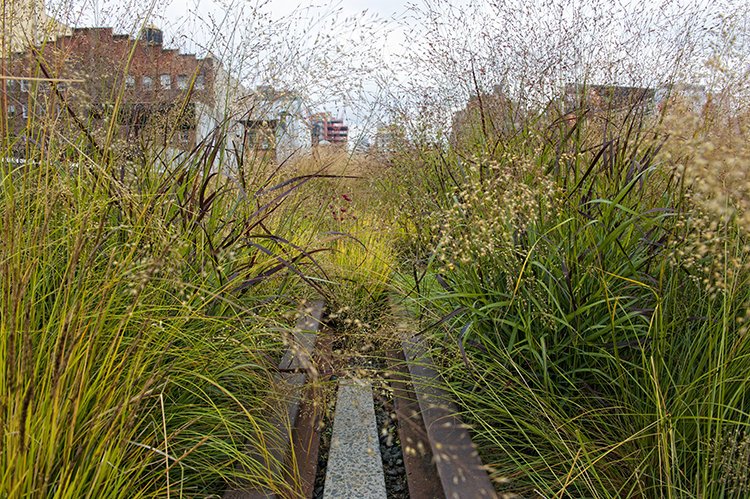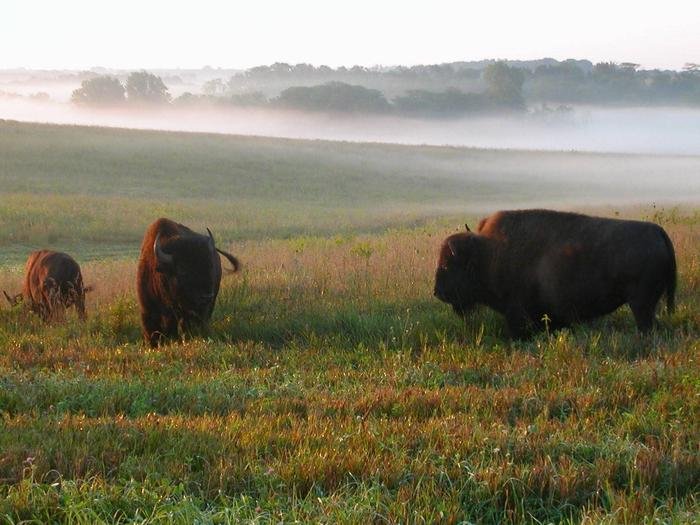I’ve spent a lot of time in the Midwest, in the corn and soybean fields that Midwestern farmers boast “feed the world”. My first trip was in November 2009, to Iowa, in the heart of the so-called “Corn Belt”. The people were friendly, but the landscape was bleak. The temperature was in the mid-thirties, with rain that always seemed on the edge of turning to snow. The fields had been tilled, stripped of even remnant corn stalks; clods of dark brown soil lay exposed to the wind and rain. Coming from Maryland, where most farmers practice no-till and grow cover crops, I was astonished to see so much bare soil. The land was flat to the far horizon, with no trees and no streams; not even a roadside hawk eking out a living on field mice. Desperate to find signs of life, I drove out one morning to visit a prairie remnant.
In contrast to everything around it, Doolittle Prairie was full of color and energy. Native grasses, their stems all shades of gold and bronze, reached for the sky. Frost-tipped spider webs sparkled with diamonds in the low sunlight. Goldfinches twittered to one another as they swayed on the seedheads of asters and goldenrod.
At the beginning of the 1800s, tallgrass prairie covered 200 million acres of the Midwest. To the early settlers, the prairie landscape seemed “so vast that it could not be subdued”. But the deep, dark soils proved highly fertile, and within 60 years most of the prairie yielded to the plow. In Iowa, less than 0.1% of native prairie survives.
Last week I was back in Iowa, and delighted to glimpse, next to my hotel, a stand of native grasses, all feathery plumes and rustling stems. Not native prairie, obviously, in the heart of Des Moines, but…something. Perhaps this was a Midwestern version of “acknowledgement to country”? Common in Australia, “acknowledgement to country” recognizes the importance of the original inhabitants of the land, the Aboriginal people and the native flora and fauna.
I was soon disappointed. The “prairie” proved to be some meagre strips of switchgrass, alternating with strips of mown turf , each decorated with a staked-down conifer. Conifers? In prairie? The combination spoke of “ease of landscape maintenance” rather than ecological design. Equally disconcerting was the planting in front of the convention center. Native grasses were laid out in a geometric grid, separated from one another by several feet of empty soil. Geometry, monoculture, hard edges, empty ground – these are the antithesis of wild prairie.
There has been something of a fashion for prairie gardens in the past decade, largely inspired by the work of Piet Oudolf. I first saw his work at The Lurie Garden in Chicago, on a summer day when the garden was a riot of colorful flowers. Later, I saw the prairie plantings on the High Line, the rewilded railway line in New York City, where the prairie concept has been fitted into a tiny space, no more than 30 feet wide. But even on this small scale, and on a January day, the plantings felt alive, grasses whispering to one another in the breeze.
The Lurie Garden, Chicago. Photograph: iStock
Chelsea Grasslands, The High Line, New York City. Photograph: iStock
Fortunately, I learned that there are landscaping companies in Iowa, that specialize in designing prairie gardens. Even more encouraging, some new housing developments around Des Moines incorporate prairie patches as part of the community. And some 20 miles east of Des Moines, prairie restoration is underway on a large scale at Neal Smith Wildlife Refuge, where over 4,000 acres of tallgrass prairie has been planted since 1990. Prairie restoration at Neal Smith was a massive effort, involving hundreds of volunteers who collected the seeds of native plants from remnant prairie patches across Iowa. Managed using the traditional, Native American techniques of prescribed burning and managed grazing, restoration success can be measured by the refuge’s ability to support healthy herds of American bison and elk – and by the delight on visitors’ faces.
Neal Smith National Wildlife Refuge.
Sometimes I dream about prairies, the swaying grasses, the hawks, the bison. I dream that someday Iowa will be more than the land of corn, that it will no longer be what a colleague called “our National Sacrifice Area” of degraded lands and polluted streams. I dream that Iowa fields will grow food for Iowans to eat. And I dream that prairies are celebrated for the stories they tell, of plants and people deep-rooted in the heartland of America.


